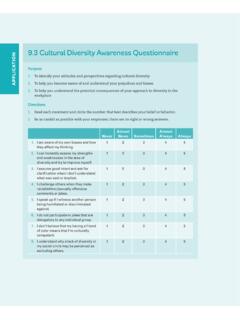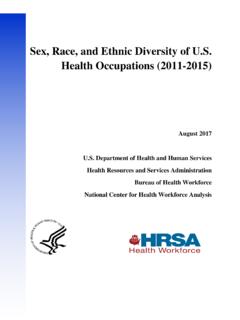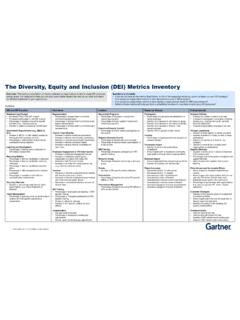Transcription of Chapter 13, Species Diversity Measures
1 Chapter 13 Species Diversity Measures (Version 5, 23 January 2014) Page BACKGROUND PROBLEMS .. 532 CONCEPTS OF Species Diversity .. 533 Species Richness .. 534 Heterogeneity .. 534 Evenness .. 535 Species RICHNESS Measures .. 535 Rarefaction Method .. 535 Jackknife Estimate .. 547 Bootstrap Procedure .. 551 Species Area Curve Estimates .. 553 HETEROGENEITY Measures .. 554 Logarithmic Series .. 555 Lognormal Distribution .. 564 Simpson's Index .. 576 Shannon-Wiener Function .. 578 Brillouin s Index .. 583 EVENNESS Measures .. 584 Simpson s Measure of Evenness .. 585 Camargo s Index of Evenness .. 586 Smith and Wilson s Index of Evenness .. 586 Modified Nee Index of Evenness.
2 587 BETA- Diversity MEASUREMENTS .. 588 RECOMMENDATIONS .. 590 SUMMARY .. 591 SELECTED REFERENCES .. 592 QUESTIONS AND PROBLEMS .. 593 Chapter 13 Page 532 A biological community has an attribute which we can call Species Diversity , and many different ways have been suggested for measuring this concept. Recent interest in conservation biology has generated a strong focus on how to measure biodiversity in plant and animal communities. Different authors have used different indices to measure Species Diversity and the whole subject area has become confused with poor terminology and an array of possible Measures . Chiarucci (2012) and Magurran and McGill (2011) have reviewed the problem. The problem at present is that we have a Diversity of Measures for communities but they do not always perform well (Xu et al.)
3 2012). In this Chapter we explore the Measures that are available for estimating the Diversity of a biological community, and focus on which Measures are best to use for conservation assessment. It is important to note that biodiversity has a broader meaning than Species Diversity because it includes both genetic Diversity and ecosystem Diversity . Nevertheless Species Diversity is a large part of the focus of biodiversity at the local and regional scale, and we will concentrate here on how to measure Species Diversity . The principles can be applied to any unit of ecological organization. BACKGROUND PROBLEMS There are a whole series of background assumptions that one must make in order to measure Species Diversity for a community.
4 Ecologists tend to ignore most of these difficulties but this is untenable if we are to achieve a coherent theory of Diversity . The first assumption is that the subject matter is well defined. Measurement of Diversity first of all requires a clear taxonomic classification of the subject matter. In most cases ecologists worry about Species Diversity but there is no reason why generic Diversity or subspecific Diversity could not be analyzed as well. Within the classification system, all the individuals assigned to a particular class are assumed to be identical. This can cause problems. For example, males may be smaller in size than females should they be grouped together or kept as two groups? Should larval stages count the same as an adult stage?
5 This sort of variation is usually ignored in Species Diversity studies. Chapter 13 Page 533 Most Measures of Diversity assume that the classes ( Species ) are all equally different. There seems to be no easy away around this limitation. In an ecological sense sibling Species may be very similar functionally while more distantly related Species may play other functional roles. Measures of Diversity can address these kinds of functional differences among Species only if Species are grouped into functional groups (Boulangeat et al. 2012) or trophic nodes (De Visser et al. 2011). Diversity Measures require an estimate of Species importance in the community. The simple choices are numbers, biomass, cover, or productivity. The decision in part will depend on the question being asked, and as in all questions about methods in ecology you should begin by asking yourself what the problem is and what hypotheses you are trying to test.
6 Numbers are used by animal ecologists in many cases as a measure of Species importance, plant ecologists may use biomass or cover, and limnologists may use productivity. A related question is how much of the community should we include in our sampling. We must define precisely the collection of Species we are trying to describe. Most authors pick one segment bird Species Diversity or tree Species Diversity and in doing so ignore soil nematode Diversity and bacterial Diversity . Rarely do Diversity Measures cross trophic levels and only rarely are they applied to whole communities. Colwell (1979) argues convincingly that ecologists should concentrate their analyses on parts of the community that are functionally interacting, the guilds of Root (1973).
7 These guilds often cross trophic levels and include taxonomically unrelated Species in them. The choice of what to include in a "community" is critical to achieving ecological understanding, yet there are no rules available to help you make this decision. The functionally interacting networks can be determined only by detailed natural history studies of the Species in a community (Baskerville et al. 2011). CONCEPTS OF Species Diversity Early naturalists very quickly observed that tropical areas contained more Species of plants and animals than did temperate areas. To describe and compare different communities, ecologists broke the idea of Diversity down into three components Chapter 13 Page 534 alpha, beta, and gamma Diversity .
8 Alpha ( ) Diversity is local Diversity , the Diversity of a forest stand, a grassland, or a stream. At the other extreme is gamma ( ) Diversity , the total regional Diversity of a large area that contains several communities, such as the eastern deciduous forests of the USA or the streams that drain into the Missouri River. Beta ( ) Diversity is a measure of how different community samples are in an area or along a gradient like from the headwaters of a stream to its mouth, or from the bottom of a mountain to the top. Beta Diversity links alpha and gamma Diversity , or local and regional Diversity (Whittaker 1972). The methods of estimating alpha and gamma Diversity are fairly straightforward, but the measurement of beta- Diversity has been controversial (Ellison 2010).
9 We will proceed first to discuss methods that can be used to estimate alpha or gamma Diversity , and discuss beta- Diversity later in this Chapter . As ecological ideas about Diversity matured and ideas of quantitative measurement were introduced, it became clear that the idea of Species Diversity contains two quite distinct concepts. Species Richness This is the oldest and the simplest concept of Species Diversity - the number of Species in the community or the region. McIntosh (1967) coined the name Species richness to describe this concept. The basic measurement problem is that it is often not possible to enumerate all of the Species in a natural community or region, particularly if one is dealing with insect communities or tropical plant assemblages.
10 Heterogeneity If a community has 10 equally abundant Species , should it have the same Diversity as another community with 10 Species , one of which comprises 99% of the total individuals? No, answered Simpson (1949) who proposed a second concept of Diversity which combines two separate ideas, Species richness and evenness. In a forest with 10 equally abundant tree Species , two trees picked at random are likely to be different Species . But in a forest with 10 Species , one of which is dominant and contains 99% of all the individuals, two trees picked at random are unlikely to be different Species . Figure illustrates this concept. Chapter 13 Page 535 The term heterogeneity was first applied to this concept by Good (1953) and for many ecologists this concept is synonymous with Diversity (Hurlbert 1971).








